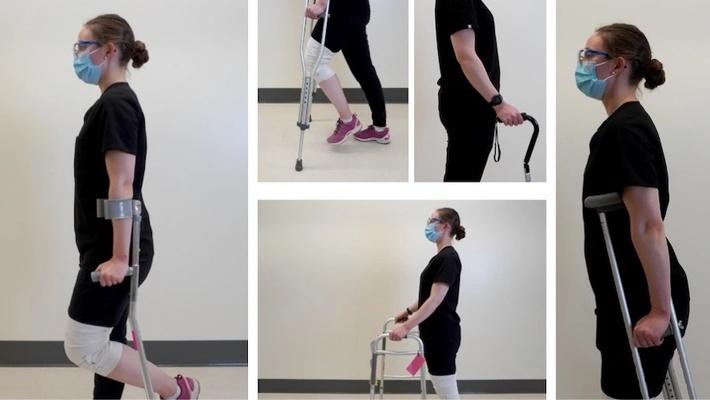Jan. 4, 2022
Interactive app helps prevent injury from incorrect use of walking aids

Walking aids such as crutches, canes and walkers are commonly used for improving mobility temporarily following an injury or for long-term conditions like cerebral palsy. Using them can put increased stress on bones, joints, and nerves in the arms and the weight-bearing leg(s). A recent UCalgary study of injuries associated with crutch use reveals that proper fitting and gait training reduce the risk of crutch-related injuries.
There is currently no standardized approach for device fitting or training for walking-aid users. Someone may receive crutches in an emergency department, at an outpatient hospital clinic, or through a drugstore. Guidance on fitting and the safe use of these aids can vary as a result.
Dr. Ranita Manocha, MD, physiatrist and clinical assistant professor in the Cumming School of Medicine, is increasing knowledge and awareness of the proper fitting and use of walking aids through an innovative mobile app she designed. She calls it ICanWALK, or Improving Canadians’ Walking Aid Learning, Skills and Knowledge. The ICanWALK app is an interdisciplinary initiative of the University of Calgary, and received financial support from the Office of Vice-President (Research) Catalyst Grant program and Alberta Innovates.
App provides interactive assessment of walking aid use
Launched in November 2021, the ICanWALK app is an interactive platform designed for patients, caregivers, and clinicians. It incorporates videos and short questions to teach and evaluate fitting walking aids and how to use them, depending on the type of injury or impairment and where a patient is in their recovery journey.

Image from ICanWALK app. Sarah Frehlich, a physiatry resident, demonstrates how to correctly use walking aids.
“As a physiatrist, I started a clinic in Calgary that evaluates how people move in their environments, and I saw many patients with poorly fitted walking aids,” explains Manocha. “So it was a clinical gap that led to the innovation of an app to prevent injuries and improve quality of life for walking-aid users with proper fitting and training.”
The ICanWALK app provides information on fitting, gait patterns and use for walking aids, including single-point canes, axillary crutches, and standard walkers.
“The app provides variations on different gait patterns depending on the type of injury a person has and where they are in their rehabilitation process. For example, after a hip replacement, people will start by adding a little bit of weight through their leg and moving their device slowly, but as they advance in their recovery, they will increase the weight through their leg and walk a bit faster, requiring a different pattern of walking,” says Manocha.
Throughout the stages of rehabilitation, users can monitor their progress through interactive assessment tools in the app. To analyze the fit of their device, users first watch an instructional video. They then take a video of themselves using their aids and then compare it, using real-time assessment questions. Afterward, users receive a score to see how well they are using the aids, with suggestions for areas of improvement.
Standardized training for health-care providers

Ranita Manocha, physiatrist and a clinical assistant professor and lead of the ICanWALK app initiative.
Quentin Collier
In addition to educating users on safely using their devices, the app could help standardize training programs for clinical therapists, nurses and pharmacists who often assist patients. By creating a tool to standardize care, Manocha hopes that patients will receive consistent guidance on their gait aids, which will help prevent secondary injuries and mitigate crutch-related pain.
“One of the goals of the program is to develop a standardized curriculum and offer the program as continuing professional development so people can continue to learn and refresh their skills,” Manocha says.
Manocha’s goal is to increase the accessibility and sustainability of the app for all Canadians. Her hope is that in the future, when someone receives crutches, they are seamlessly provided with information and assistance on fitting and use directly through their smartphone.
Ranita Manocha is a physiatrist and a clinical assistant professor in the Division of Physical Medicine and Rehabilitation in the University of Calgary’s Cumming School of Medicine and a member of the McCaig Institute for Bone and Joint Health and the Hotchkiss Brain Institute.
About the ICanWALK app
The ICanWALK app was an interdisciplinary bilingual initiative. In building the app, the research team received guidance and input from local physiotherapists and occupational therapists on various walking aids. Quentin Collier of the Department of Clinical Neurosciences provided photography and videography services. Dr. Larry Katz, professor in the Faculty of Kinesiology at the University of Calgary, and Andrea Oh, CEO of Move Improve, helped to map out the app through their experiences using similar interactive methods in the teaching and learning of sport skills. Drs. Krista Best, François Routhier, and Bill Miller (Université Laval and University of British Columbia) provided mentorship on the app content and research implementation.
To learn more about the ICanWALK app and to download it for free, please visit the ICanWALK website.






